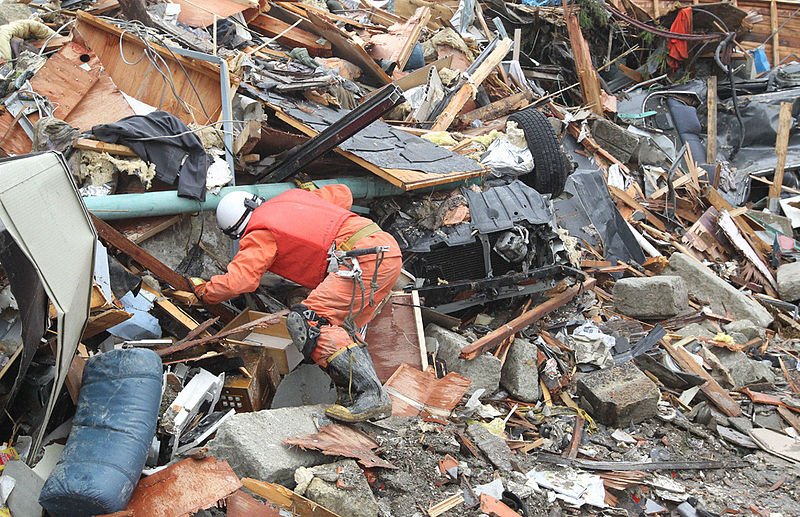Earthquake resistant building materials

|
| Rescue teams in Natori, Japan search for missing people in the aftermath of the 2011 quake. |
Contents |
[edit] Introduction
Seismic events known as earthquakes occur when the earth 'shakes' due to the release of energy below its surface. This energy can be caused by natural events (such as volcanoes or landslides) or occasionally by human activity (such as mine blasts or underground nuclear experiments) and can cause significant damage to structures in their path.
Several building materials have been developed to improve the resilience of structures to earthquakes.
[edit] Fibre reinforced paint
In 2014, a team of researchers at The University of Tokyo introduced glass-fibre reinforced paint referred to as SG2000. Headed up by Kenjiro Yamamoto, the team began experimenting with techniques that could be used to retrofit masonry structures in areas where earthquakes were likely to occur.
Their research resulted in the development of SG2000 - a coating made from standard acrylic-silicone paint resin and glass fibres. During laboratory tests, the coating, which is simple to apply to existing structures, was able to help keep bricks connected after mortar joints - which had been covered with the coating - were broken (thus reducing the likelihood of injury caused by falling bricks). It also showed that the coating - which did not increase the test building’s stiffness - allowed masonry structures to bend rather than break or collapse.
[edit] Earthquake resistant concrete
In October 2017, the University of British Columbia introduced a seismic-resistant, fibre-reinforced concrete. Referred to as eco-friendly ductile cementitious composite (EDCC), the material is engineered at the molecular scale to be strong, malleable, and ductile, similar to steel—capable of dramatically enhancing the earthquake resistance of a seismically vulnerable structure when applied as a thin coating on the surfaces.
EDCC combines cement with polymer-based fibres, fly ash and other industrial additives, making it highly resilient, according to UBC civil engineering professor Nemy Banthia, who supervised the work.
To test its effectiveness, the product was sprayed on walls to a thickness of 10mm, which was deemed sufficient by the research team. The test walls were then subjected to high levels of vibration (equivalent to the magnitude 9.0–9.1 earthquake that struck Tohoku, Japan in 2011) and other types and intensities of earthquake. After passing all tests, EDCC was given its first real-life application in the seismic retrofit of a Vancouver elementary school.
The research was funded by the UBC-hosted Canada-India Research Centre of Excellence IC-IMPACTS, which promotes research collaboration between Canada and India. IC-IMPACTS has made EDCC available to retrofit a school in Roorkee in Uttarakhand, a highly seismic area in northern India.
Other EDCC applications include resilient homes, pipelines, pavements, offshore platforms, blast-resistant structures and industrial floors.
[edit] Related articles on Designing Buildings Wiki
- Concrete fibre.
- Cool paint.
- Earthquakes and the seismic strengthening of churches.
- Earthquake Design Practice for Buildings.
- Fly ash.
- Glass fibre reinforced concrete.
- Managing and responding to disaster.
- Paints and coatings.
- Ultra high performance fibre concrete.
[edit] External resources
- Kenjiro Yamamoto, Muneyoshi Numada and Kimiro Meguro, Shake table tests on one-quarter scaled models of masonry houses retrofitted with fiber reinforced paint.
- University of British Columbia, UBC researchers develop earthquake-resistant concrete.
Featured articles and news
RTPI leader to become new CIOB Chief Executive Officer
Dr Victoria Hills MRTPI, FICE to take over after Caroline Gumble’s departure.
Social and affordable housing, a long term plan for delivery
The “Delivering a Decade of Renewal for Social and Affordable Housing” strategy sets out future path.
A change to adoptive architecture
Effects of global weather warming on architectural detailing, material choice and human interaction.
The proposed publicly owned and backed subsidiary of Homes England, to facilitate new homes.
How big is the problem and what can we do to mitigate the effects?
Overheating guidance and tools for building designers
A number of cool guides to help with the heat.
The UK's Modern Industrial Strategy: A 10 year plan
Previous consultation criticism, current key elements and general support with some persisting reservations.
Building Safety Regulator reforms
New roles, new staff and a new fast track service pave the way for a single construction regulator.
Architectural Technologist CPDs and Communications
CIAT CPD… and how you can do it!
Cooling centres and cool spaces
Managing extreme heat in cities by directing the public to places for heat stress relief and water sources.
Winter gardens: A brief history and warm variations
Extending the season with glass in different forms and terms.
Restoring Great Yarmouth's Winter Gardens
Transforming one of the least sustainable constructions imaginable.
Construction Skills Mission Board launch sector drive
Newly formed government and industry collaboration set strategy for recruiting an additional 100,000 construction workers a year.
New Architects Code comes into effect in September 2025
ARB Architects Code of Conduct and Practice available with ongoing consultation regarding guidance.
Welsh Skills Body (Medr) launches ambitious plan
The new skills body brings together funding and regulation of tertiary education and research for the devolved nation.
Paul Gandy FCIOB announced as next CIOB President
Former Tilbury Douglas CEO takes helm.
UK Infrastructure: A 10 Year Strategy. In brief with reactions
With the National Infrastructure and Service Transformation Authority (NISTA).






















